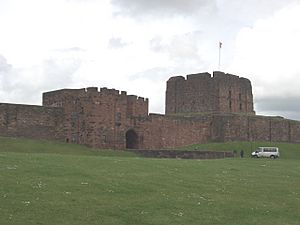Siege of Carlisle (November 1745) facts for kids
Quick facts for kids First Siege of Carlisle |
|||||||
|---|---|---|---|---|---|---|---|
| Part of the Jacobite rising of 1745 | |||||||
 A present-day view of Carlisle Castle |
|||||||
|
|||||||
| Belligerents | |||||||
| Commanders and leaders | |||||||
| Strength | |||||||
| Unknown | Unknown | ||||||
| Casualties and losses | |||||||
| Unknown | Unknown | ||||||
The First Siege of Carlisle was a key event during the Jacobite rising of 1745–1746. During this time, supporters of Prince Charles Edward Stuart (called Jacobites) took control of Carlisle city and Carlisle Castle. This happened on November 14–15, 1745.
Contents
Why Carlisle Was Important
The Jacobite leader, Prince Charles Edward Stuart, heard that a British general named George Wade was bringing his army from Newcastle. General Wade was planning to help the city of Carlisle. Charles Stuart decided to stop Wade's army on the hills between Newcastle and Carlisle.
On November 11, 1745, Charles Stuart left some of his soldiers to block Carlisle. He then marched with the rest of his army towards Brampton.
A Change of Plans
When Charles Stuart reached Brampton, he sent a group of horsemen to check on General Wade. They found out that the news about Wade marching to Hexham was not true. Charles waited in Brampton for two days, but he heard nothing more about Wade.
So, Charles held a meeting with his commanders. They discussed what to do next. Some thought they should march to Newcastle and fight Wade. Others worried this was too risky. They thought Wade's army might hide in Newcastle, which would be hard to capture. Some even suggested going back to Scotland to gather more Jacobite allies.
A New Strategy for Carlisle
Lord George Murray, a respected Jacobite commander, had a different idea. He suggested that half of their army should stay in Brampton. The other half would then attack Carlisle. James Drummond, 3rd Duke of Perth agreed with Murray. He offered to lead the attack on Carlisle while Murray managed the blockade.
The attacking group left the main army in Brampton. They cut down wood from nearby parks to build ladders and carts. These tools would help them climb the city walls.
The Siege Begins
On November 13, around noon, the Jacobite regiments arrived at Carlisle. Lord George Murray set up his base and placed his soldiers in villages around the city. This stopped anyone from getting in or out of Carlisle.
That evening, the attacking soldiers began digging trenches close to the city walls. The city's defenders fired their guns at the Jacobites. But because it was dark, the Jacobites were not hurt. Soon, the Jacobites brought up all their cannons, which were thirteen in total, to attack the town.
The next morning, November 14, the defenders kept firing, but it didn't do much. The Jacobite attackers, instead of firing back, held up their hats on their spades. This was a way of making fun of the defenders.
Carlisle Gives Up
The people inside Carlisle became worried. They saw the Jacobites getting ready for a big attack. A meeting was held, and the English people in the city decided to surrender. For seven days, the Jacobites had kept the town on edge. Many people were sick or leaving the city by climbing over the walls.
A white flag was raised from the walls, and a messenger was sent to the Duke of Perth. The messenger asked for terms of surrender. However, Prince Charles said he would only accept the city's surrender if Carlisle Castle also gave up.
Colonel Durand, who was in charge of the castle, agreed to surrender both the castle and the town. The conditions were:
- The people's freedom and property would be safe.
- The town's special rights would be kept.
- Both groups of defenders would promise not to fight against the Stuart family for one year.
- All weapons, ammunition, and horses belonging to the local soldiers would be given to the prince.
The Duke of Perth and Colonel Durand signed this agreement on the night of November 14, 1745.
Jacobites Enter Carlisle
The next morning, November 15, the Duke of Perth, James Drummond, led his soldiers into the city. Other regiments followed him. Carlisle Castle was handed over the following morning. The Duke of Perth shook hands with the castle's defenders. He told them they were brave and offered them money to join Prince Charles's army.
The mayor of Carlisle went to Brampton and gave the city's keys to Prince Charles. The Duke of Perth found 1,000 guns in the castle. He also found 200 good horses and many valuable items that local wealthy people had stored there for safety.
What Happened Next
After Carlisle surrendered, Prince Charles Edward Stuart's father, the Chevalier de St. George, was officially announced as king in the city. The mayor and other city leaders had to attend the ceremony.
Taking Carlisle was very important for Prince Charles. It showed how much fear his army could cause in England. However, his army was not strong enough to achieve his main goal. Even if he had more resources, disagreements among his commanders made things difficult.
Later, in 1746, when Charles Edward Stuart's Jacobite army was retreating, he ordered the Manchester Regiment to stay and protect Carlisle. He wanted to keep at least one town in England. But the Hanoverian army, led by the Duke of Cumberland, then attacked and took Carlisle back. Today, Carlisle Castle is still home to the King's Own Royal Border Regiment.
See also
- Charles Edward Stuart
- Jacobite risings
- Carlisle Castle
- Siege of Carlisle

